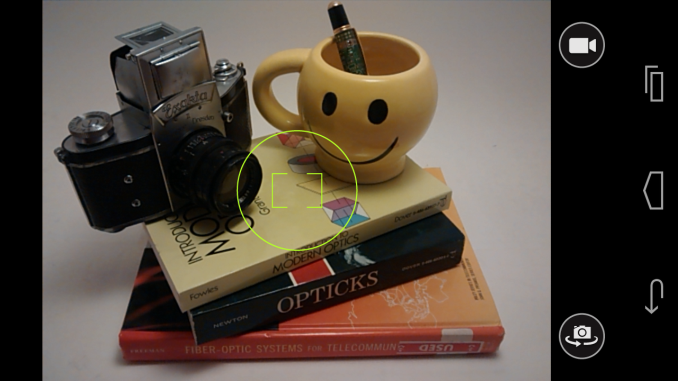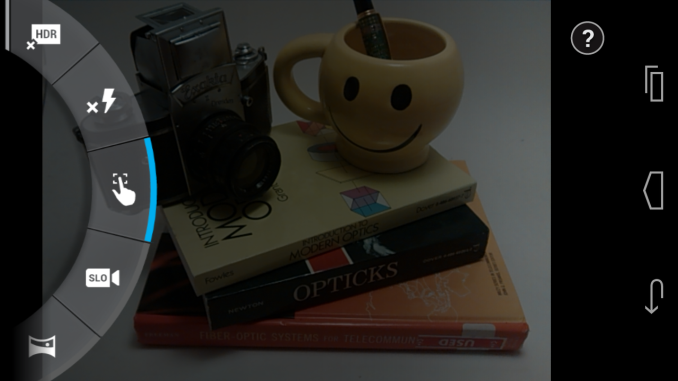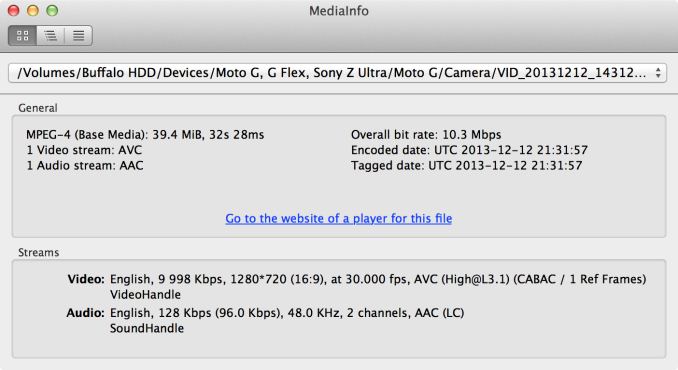Motorola Moto G Review
by Brian Klug on December 18, 2013 2:00 PM EST- Posted in
- Smartphones
- Motorola
- Mobile
- *VA
- Cortex A7
- snapdragon 400
- Moto G
On the camera side the Moto G includes a 5 MP rear facing camera with autofocus and LED flash, on the front it includes a 1.3 MP camera. I did some digging and found that the rear facing camera CMOS is an Aptina AR0543 CMOS. There’s nothing on Aptina’s website about the AR0543, but there is an AR0542 which probably is its predecessor with 1/4 Inch format and 1.4 μm pixels. I suspect this is exactly the form factor of the sensor in Moto G, with some slight improvements, I believe the color filter array is Bayer as well, not RGBW like Moto X. The rear facing camera module has a focal length of 3.5 mm which works out to around a 37mm focal length in 35mm-equivalent units, the system has an F/# of 2.4, which is great for a device of this cost.
On the front is the Aptina MT9M114 1.3 MP, 1/6 Inch with 1.9 µm pixels sensor that we’ve seen a lot of in recent days.
Motorola uses the same camera application as the Moto X, and reflects the most recent UI changes that have rolled out in both OTAs and through the Play Store. The biggest change is a new spot focus and exposure point which can be dragged around the live preview. Motorola calls it manual focus and exposure, in practice it’s really a weighted spot meter and focus point that you can drag around. I’d only call what LG has on the G2 or Nokia bundles as manual focus, but the new camera app is a substantial improvement over the UI as it launched with the Moto X, which didn’t afford any exposure or metering controls (instead taking a scene average), only tap to focus, which ran a full AF search wherever you tapped.
The camera settings menu still is a ring chooser that slides out with a drag from the left side, and has settings for HDR, flash, tap to focus/expose, slow motion video, panorama, location, a new aspect ratio toggle (16:9 and 4:3) and shutter sound. The aspect ratio toggle is what’s new versus the X, since the Moto G has a standard 4:3 aspect ratio sensor and not the 16:9 aspect ratio aspect ratio of the Moto X. By default the Moto G launches with the 16:9 aspect ratio for image capture, cropping off part of the image area, but tapping 4:3 gives you a proper live, full field of view, 4:3 preview. Major kudos to Motorola for giving an aspect-correct live preview. Shot to shot latency is longer than Moto X or other flagships, but not inordinately long or on the order of seconds. I should note that the Moto G does not include the same wrist-flick camera activation gesture as the Moto X.
To evaluate image quality we turn to the usual combination of photos taken at the bench locations, although location 7 wasn’t available, and photo tests in a lightbox with lights on, and off, and of test charts. I also continue to take photos while out and about with devices to get samples in a variety of other conditions.
Moto G still image quality is better than I had suspected. Outdoors in well lit scenes the Moto G is totally capable of delivering good quality shots with good exposure and focus.
My only major criticism is that there’s definitely some off-axis loss of sharpness, the leftmost part of almost every image gets blurry quickly, the right side doesn’t show nearly as much. Alignment tolerances for smartphone optics are a part of module cost, I wouldn’t be surprised to see variance like this. In low light or indoors, the Moto G occasionally struggles to produce images without blur, but that’s a complaint I still levy against some modern flagships. There’s also a bit of light leakage on the Moto G which crops up when outdoors, but nothing crazy. Front facing camera quality is totally par with other flagships I’ve tried, which isn’t surprising.
Camera - Video
On the video side, the Moto G’s interface is, no surprise, just like the Moto X. There’s a video button that immediately starts video capture, successive taps in the image area capture still frames from the live video. Although MSM8x26 supports up to 1080p30 video encode for H.264, Moto G oddly enough captures video at 720p30 in H.264 High profile at 10 Mbps. Audio is stereo thankfully at 128 kbps AAC.
As always I’ve uploaded a copy of the video recorded at the usual place to YouTube and to our servers for you to look at without the additional compression.
Video from the Moto G is well exposed and appears great for being 720p. I would personally miss 1080p, but the Moto G seems great for the resolution it affords. There’s no dropped frames or visible macroblocking, and exposure seems good, again my only desire would be for 1080p resolution.























































120 Comments
View All Comments
user777 - Friday, January 3, 2014 - link
HTC Desire 300/500/600 models are intended to the same market niche.carancho - Wednesday, December 18, 2013 - link
I'd have even greater doubts when it comes to Motorola's promises. They've eft their previous flagship customers in the cold, as the RAZR HD is still on Android 4.1 and with no indications of ever being updated. The phone was out several months AFTER Google's acquisition, and it compares horrible with the treatment that Samsung and HTC's customers got.Really, Motorola has been promising updates generation after generation, and never shipping them. Do not trust them, you'll get burned.
blanarahul - Wednesday, December 18, 2013 - link
Jelly Bean doesn't need a update that badly.But I guess you can't blame Qualcomm for it since the S3 is already on Android 4.3.
carancho - Thursday, December 19, 2013 - link
The local version that I have of the RAZR HD has several major bugs. At least a revision to 4.1 would be needed.Notice that Googlerola has provided ZERO updates for the RAZR HD in terms of providing updates not available prior to the launch (as was the case with 4.1).
RMSe17 - Wednesday, December 25, 2013 - link
Actually, I wold consider any android pre-4.4 (and thus not having pre-compilation) as completely obsolete.razorsbk - Saturday, December 28, 2013 - link
RAZR HD is officialy supported by CyanogenMod, and CM 10.1 stable is available for it.jeffkibuule - Wednesday, December 18, 2013 - link
If you care about updates, don't get anything besides a Nexus. Simple as that.uhuznaa - Wednesday, December 18, 2013 - link
And even then you can stop caring 18 months later.sprockkets - Wednesday, December 18, 2013 - link
Referring to the Galaxy Nexus? Guess what? The 18 month thing is a red herring.Google has updated all their phones longer than 18 months. That also *includes* the Gnex. That's right, it got 4.3 *19 months* into its life.
TI dissolved its OMAP team. No one can update the drivers for it anymore.
Still won't believe me? Google is replacing free of charge all 1st gen google glasses because it can't be updated. It also uses OMAP.
uhuznaa - Thursday, December 19, 2013 - link
It's Google who said that it will support Nexus phones for 18 months, not me.